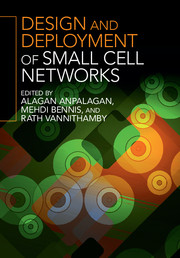Book contents
- Frontmatter
- Contents
- List of contributors
- Preface
- 1 Mobility performance optimization for 3GPP LTE HetNets
- 2 Design and performance analysis of multi-radio small cell networks
- 3 Dynamic TDD small cell management
- 4 3GPP RAN standards for small cells
- 5 Dense networks of small cells
- 6 Traffic offloading scenarios for heterogeneous networks
- 7 Required number of small cell access points in heterogeneous wireless networks
- 8 Small cell deployments: system scenarios, performance, and analysis
- 9 Temporary cognitive small cell networks for rapid and emergency deployments
- 10 Long-term evolution (LTE) and LTE-Advanced activities in small cell networks
- 11 Game theory and learning techniques for self-organization in small cell networks
- 12 Energy efficient strategies with BS sleep mode in green small cell networks
- 13 Mobility management in small cell heterogeneous networks
- 14 The art of deploying small cells: field trial experiments, system design, performance prediction, and deployment feasibility
- 15 Centralized self-optimization of interference management in LTE-A HetNets
- 16 Self-organized ICIC for SCN
- 17 Large-scale deployment and scalability
- 18 Energy efficient heterogeneous networks
- 19 Time- and frequency-domain e-ICIC with single- and multi-flow carrier aggregation in HetNets
- Index
- References
8 - Small cell deployments: system scenarios, performance, and analysis
Published online by Cambridge University Press: 05 December 2015
- Frontmatter
- Contents
- List of contributors
- Preface
- 1 Mobility performance optimization for 3GPP LTE HetNets
- 2 Design and performance analysis of multi-radio small cell networks
- 3 Dynamic TDD small cell management
- 4 3GPP RAN standards for small cells
- 5 Dense networks of small cells
- 6 Traffic offloading scenarios for heterogeneous networks
- 7 Required number of small cell access points in heterogeneous wireless networks
- 8 Small cell deployments: system scenarios, performance, and analysis
- 9 Temporary cognitive small cell networks for rapid and emergency deployments
- 10 Long-term evolution (LTE) and LTE-Advanced activities in small cell networks
- 11 Game theory and learning techniques for self-organization in small cell networks
- 12 Energy efficient strategies with BS sleep mode in green small cell networks
- 13 Mobility management in small cell heterogeneous networks
- 14 The art of deploying small cells: field trial experiments, system design, performance prediction, and deployment feasibility
- 15 Centralized self-optimization of interference management in LTE-A HetNets
- 16 Self-organized ICIC for SCN
- 17 Large-scale deployment and scalability
- 18 Energy efficient heterogeneous networks
- 19 Time- and frequency-domain e-ICIC with single- and multi-flow carrier aggregation in HetNets
- Index
- References
Summary
Mobile device data rates are increasing at effectively Moore's law [1] due to the fact that mobile devices are all integrated in silicon and thus are taking advantage of the reduction in geometry and increase in functionality and the number of transistors per die. The current cellular approach of using large outdoor base station towers to provide mobile broadband via wireless communications, however, does not scale efficiently to cope with the forecast 13-fold increase expected by 2017 [2]. Thus a need for a new approach is required. As we will discuss in this chapter, small cell deployments have the potential to provide a scalable solution to this demand where they are beginning to change the network topology into a so-called heterogeneous network (HetNet) containing a mix of different cell sizes and cell power levels, as shown in Figure 8.1. This will lead to a mix of macro cells, micro cells, pico cells, and femto cells. This deployment is not as uniform as outdoor macro cells with different cell sizes and a much more irregular deployment results.
As we will show in this chapter, small cell network (SCN) deployments provide, for the first time, a low-cost efficient scalable architecture to meet the expected demand. This technology was initially deployed in large scale when femto cells (residential small cells) were first deployed by a number of leading wireless operators (including Vodafone and AT&T). The solution was enabled by two key developments, namely:
• low-cost chip-sets (a so-called “system-on-chip”), which included the entire signal processing and most of the radio software stack, and
• high-speed internet access (greater than Mbps) was available, thus providing the so-called “backhaul” (the connectivity into the network) for these access points.
These developments mean that with volume the effective capital costs of small cells are negligible compared to the cost of deployment and operating costs.
Small cell deployments have a range of topologies and configurations that will depend on the location and the demand requirements. For example, downtown city areas will consist of a combination of small cells where they will exist:
on outdoor light poles to serve “hotspot” traffic needs around cafes and other places where users congregate
in city buildings to serve enterprise customers with high demands on throughput and reliability
in apartments or residential homes to serve private users' needs.
- Type
- Chapter
- Information
- Design and Deployment of Small Cell Networks , pp. 169 - 190Publisher: Cambridge University PressPrint publication year: 2015



